 Website:
Habasit
Website:
Habasit
Group: Habasit
Catalog excerpts

Fabric Conveyor Belts Engineering Guide Habasit– Solutions in motion F [N
Open the catalog to page 1
Product liability, application considerations If the proper selection and application of Habasit products are not recommended by an authorized Habasit sales specialist, the selection and application of Habasit products, including the related area of product safety, are the responsibility of the customer. All indications / information are recommendations and believed to be reliable, but no representations, guarantees, or warranties of any kind are made as to their accuracy or suitability for particular applications. The data provided herein are based on laboratory work with small-scale test...
Open the catalog to page 3
Objective of the Engineering Guide The objective of this Engineering Guide is to provide a comprehensive, albeit summarized overview of the most important aspects of the design of conveyor systems as it pertains to light fabric conveyor belts. Special emphasis has been placed on belt tracking measures. Light fabric conveyor belts Light fabric conveyor belts are, according to the International Standard ISO 21183-1 “Light conveyor belts - Principal characteristics and applications”, predominantly used for the indoor transport of unit loads, like industrial goods of all kinds and foodstuffs,...
Open the catalog to page 4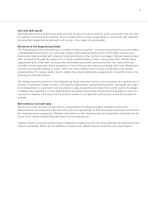
Unit and bulk goods Although fabric belt conveyors are used primarily to convey small to medium sized unit goods, they can also be used for conveying bulk materials. As far as fabric belt conveyor engineering is concerned, bulk materials are generally categorized as granular, such as corn, rice, sugar or even powder. Structure of the Engineering Guide This Engineering Guide is divided into a number of distinct chapters - each providing easily found and readily understandable information on a particular subject. More detailed performance information and common themes are clearly marked with...
Open the catalog to page 5
Belt conveyor components System components In its simplest form, a belt conveyor consists of a driving pulley (often the head pulley), a tail pulley, the tensioning device, a conveyor belt, and the supporting structure with the belt support (slider bed or carrying rollers). Example: Head-driven conveyor Example: Center-driven conveyor 1 Driving pulley 6 Deflection roller (idler) 2 Head or tail pulley (dep. on belt running direction) 7 Tension pulley (take-up pulley) 3 Slider bed 8 Carrying roller (on the return side) 4 Carrying roller 9 Conveyor belt 5 Snub pulley 10 Guiding pulley Sign for...
Open the catalog to page 6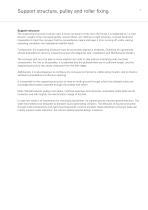
Support structure, pulley and roller xing Support structure The supporting structure must be rigid. It must not distort or ex from the forces it is subjected to, i.e. belt tension, weight of the conveyed goods, uneven oors, etc. Without a rigid structure, it would be almost impossible to track the conveyor belt by conventional means and keep it from running off under varying operating conditions (no load/partial load/full load). Furthermore, the supporting structure must be accurately aligned in all planes. Checking for squareness should preferably be done by measuring across the diagonals...
Open the catalog to page 7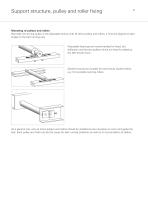
Support structure, pulley and roller xing Mounting of pulleys and rollers Normally, the driving pulley is not adjustable and as with all other pulleys and rollers, it must be aligned at right angles to the belt running axis. Adjustable bearings are recommended for head, tail, deection and tension pulleys which are heavily loaded by the belt tensile force. Slotted mounts are suitable for less heavily loaded rollers, e.g. for pivotable carrying rollers. As a general rule, only as many pulleys and rollers should be installed as are necessary to carry and guide the belt. Each pulley and roller...
Open the catalog to page 8
Belt support Slider bed The advantages of a belt supported by means of a slider bed are primarily that the transported goods lay with greater stability on the belt, and it presents virtually no inuence on belt tracking – a distinct benet versus a similar design which employs carrying rollers. With the correctly selected belt (with appropriate running side fabric) and slider bed material it is possible to favorably inuence the coefcient of friction, running noise and the belt service life. Preferred slider bed materials are: • Pickled steel sheet (chemically descaled steel sheet) • Stainless...
Open the catalog to page 9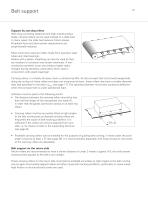
Belt support Support by carrying rollers With long conveying distances and high overall product loads, carrying rollers can be used instead of a slider bed. In many cases, the roller bed reduces friction losses. Peripheral force and drive power requirements are proportionally reduced. Most commonly used are rollers made from precision steel tubes and roller bearings. Rollers with a plastic sheathing can also be used as they are resistant to corrosion and certain chemicals. A nonconductive synthetic cover can produce higher static charges during operation, particularly when used in...
Open the catalog to page 10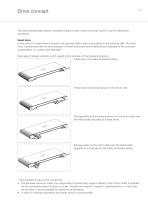
Drive concept The following standard system illustrations depict those most commonly found in use for fabric belt conveyors. Head drive In the case of a head-driven conveyor, the conveyor belt is said to be pulled on the carrying side. The head drive is preferred to the tail drive because of lower belt stress and smaller forces imparted to the conveyor components, i.e., pulleys and bearings.1) Examples of design variations with regard to the position of the tensioning device: Head drive, tail pulley as tension pulley. Head drive, tensioning device on the return side. Driving pulley and...
Open the catalog to page 11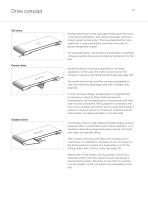
Drive concept Tail drive Greater belt tensile forces and higher shaft loads that occur in tail-driven installations may demand stronger and more robust system construction. This issue becomes far more signicant in long installations and where the mass of goods transported is great. As mentioned above, the tail drive is preferable on declined conveyors as the drive acts as a braking mechanism for the belt. Center drive Center drives are commonly specied for reversing operations. In this case, the rollers at each end of the conveyor may have cylindrical-conical shape (see page 19). The center...
Open the catalog to page 12All Habasit catalogs and technical brochures
-
Meat and Poultry Industry
24 Pages
-
Textile Industry
24 Pages
-
Bakery Industry
20 Pages
-
HabaSYNC® Wide Timing Belts
4 Pages
-
E-RB-F
2 Pages
-
Higher Chain Conveyor Speeds
4 Pages
-
NHM-10ELBV-E3
3 Pages
-
ENI-5EE
3 Pages
-
ENI-5P
3 Pages
-
ENI-12P
3 Pages
-
HabaSYNC Timing Belts
76 Pages
-
Habasit America
4 Pages
-
Specialty Belts & Components
2 Pages
-
HabaSYNC® WH-A-02
2 Pages
-
HabiPLZST Guides and Profiles
60 Pages
-
Habasit Cleandrive™
16 Pages
-
Habasit Crosslapper Belts
6 Pages
-
Material Handling Industry
20 Pages
-
Tape MVT-6P
2 Pages
-
MVM-5E Machine Tape
2 Pages
-
MAV-5E Machine Tape
2 Pages
-
Flexfold
2 Pages
-
HabaCHAIN
4 Pages
-
Details about Yarn Processing
28 Pages
-
Handling and Maintenance
24 Pages
-
Textile Industry
12 Pages
-
Confectionery Industry
22 Pages
-
HySAN Food Conveyor Belts
4 Pages
-
EU Food Regulations
6 Pages
-
Beverage Industry
34 Pages
-
Tire Industry
20 Pages
-
Automotive Industry
4 Pages
-
Airport Industry
12 Pages
-
GRABBER FFS Series
4 Pages
-
Habiblue
2 Pages
-
Product Guide HabasitLINK
306 Pages
-
Thermoplastic Extruded Profiles
19 Pages
-
HabaDRIVE
4 Pages
-
Habasit Spiral Belts
12 Pages
-
MNI-7E Machine Tape
2 Pages
-
Habasit Cleanline (4063)
12 Pages
-
Printing Blanket ENU-50AXBD
2 Pages
-
Habasit Fitline TMBE02404
4 Pages
-
Habasit Eff-Line belts
4 Pages
-
Habasit Cleanline
12 Pages
-
HabaCHAIN Product Guide
128 Pages
-
HabasitLINK®
100 Pages
-
Packaging Industry
26 Pages
-
Wood Industry (2055)
24 Pages
-
Tobacco Industry (2010)
16 Pages
Archived catalogs
-
Habasit Tire Industry (2036)
32 Pages
-
Habasit Yarn Processing (2006)
28 Pages
-
Habasit Bakery (2005)
28 Pages






















































































